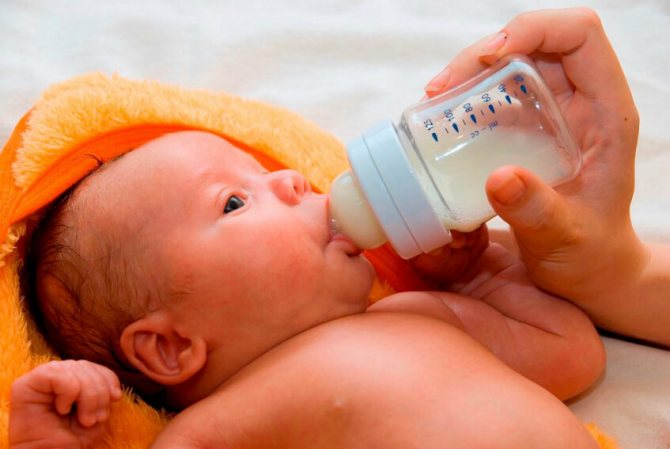What does failure look like?
If a newborn begins to latch poorly, the mother will probably notice it immediately. A child’s refusal can look different:
- The baby stopped latching altogether
- Eats only from one breast, ignoring the other
- Sucks milk only when half asleep or asleep
- He can take the breast, spit it out, then starts freaking out and crying. After which he takes it again and is capricious again. And so in a circle
- The child turns away, bends over, prefers a pacifier instead of a breast
As the baby grows older, he may be distracted while eating by various noises, movements, and objects. This is normal and has nothing to do with breast refusal
If an infant refuses to breastfeed in the first months of life, there are good reasons for this. And this has nothing to do with the manifestation of his character. A nursing woman needs to identify these causes as quickly as possible and, if possible, eliminate them.
Reasons why a baby stopped breastfeeding
Before solving the problem of breast refusal, it is necessary to understand what exactly led to this. There are various reasons why a newborn may not want to latch on. Among the most common are the baby’s health condition and the anatomical features of the mother’s breast. However, there are a number of other reasons why a baby ignores breastfeeding. But first things first.
Baby's health status
If previously there were no problems with latching, then the baby suddenly stopped breastfeeding, then the reason may be a new illness.
- Colds, nasal congestion, or your baby has a sore throat. During this period, appetite decreases, and difficulty breathing through the nose prevents the baby from sucking the breast. Because of this, the baby is constantly interrupted during feeding. Saline solutions, ventilation, and air humidification will help with congestion. If your child has a fever, you should definitely consult a doctor.
- Intestinal problems. During the period of colic, increased gas formation, and constipation, children are very capricious, often cry and jerk their legs. In this case, dill water and a tummy massage, or another medicine prescribed by a doctor, can help.
- Oral diseases, thrush. To treat inflammation, you need to consult a doctor who will examine the child and prescribe treatment. In the meantime, you can feed your baby expressed milk using a spoon.
- Teething. During this period, babies behave differently - for some children, their first teeth appear almost painlessly, others need their mother’s breast for hours on end, and some completely ignore it. For temporary relief, you can use special teethers, ointment or gel.

If the mother notices any symptoms of the disease, measures must be taken immediately. Thanks to this, it will be possible to maintain breastfeeding and also prevent possible complications.
The most common reasons are listed here, but in reality everything is very individual. It is important that the mother always pays close attention to the condition of her baby and monitors changes. In any situation that raises suspicions, you should consult a doctor.
Anatomical structure of the breast
A child may also refuse to breastfeed due to certain individual structural features of the mammary glands. For example, small, flat or very elongated nipples can make eating difficult. In addition, this also includes the extremely narrow channels through which breast milk passes. For these reasons, as a rule, it is uncomfortable for a child to suckle at the breast from birth.
Unfortunately, such data that nature has awarded is very difficult to change. Therefore, a woman needs to immediately help her baby correctly master breastfeeding techniques. Mom should massage her breasts and regularly express milk with a breast pump. This will help maintain lactation and eliminate chest tightness. There are also special breast pads on the market that can facilitate the process of natural feeding. After some time, when the baby grows a little, he will learn to grasp the nipple correctly.
Other reasons
If the mother is sure that breast refusal is definitely not connected either with the health of the baby or with the structural features of the mammary glands, the reason should be looked for elsewhere and the problem should be solved as soon as possible. Below we will look at the most common options for why a newborn begins to suckle poorly.
- Incorrect application. Because of this, the baby may not receive enough breast milk. The baby does not eat enough and swallows air, resulting in colic. We recommend that you familiarize yourself with the series of webinars on the basics of breastfeeding
- Taste of breast milk. Some products can change the taste of milk, making it bitter, sour, and tasteless to the baby. Naturally, the baby will not want to eat such food. Therefore, a parent should be careful about her daily diet. Improper nutrition can not only change the taste of milk, but also cause colic, gas formation, and diathesis, which causes great discomfort to the baby. An unpleasant taste may also be due to a hormonal surge (for example, pregnancy)
- Large quantities of milk. In this case, the flow of milk is too abundant for the baby, which frightens the baby and he may refuse to latch on.
- Lack of milk. If, on the contrary, there is too little milk, then the child cannot get enough and remains constantly hungry. At the same time, he cries and gets nervous. In such a situation, a nursing woman needs to take measures to increase the amount of breast milk.
- Foreign and pungent odor. While the baby is still very small, it is best to give up perfumes and deodorants. A smell that is too intrusive can frighten the baby, because he has been accustomed to the natural smell of his mother since birth.
- The introduction of the first complementary foods can also affect breast refusal. As the baby grows up, he becomes acquainted with new foods and new tastes, which he may like more than mother's milk.
- Any stressful situation for the baby can provoke breast refusal. This could be scandals in the family, a negative reaction from the mother (for example, if the child bit the nipple), or any other situation in which the baby received strong negative emotions.
Why won't my baby latch on after a bottle?
Very often, parents resort to using a baby bottle to feed their baby. In some cases, this happens due to mixed feeding (when, in addition to breast milk, the child receives baby formula), in others, when the mother needs to go away on business and the baby is bottle-fed with pre-expressed milk. In any case, such feeding can cause the baby to refuse the breast.

Why does the baby stop breastfeeding? Everything is very simple: in order to eat from a bottle, the baby does not need to make any effort at all, because the milk very easily enters the newborn’s mouth. At the same time, he does not strain, does not get tired, and eats up in a short time.
If it is still not possible to breastfeed your baby, then it is better to use a spoon, pipette, or a syringe without a needle.
Why does a baby cry when feeding?
Let's try to take a closer look at why a baby cries during feeding:
- I have a stomachache. Infantile colic is a common phenomenon caused by the immaturity of the intestinal microflora and enzymatic system. The food in the baby's stomach is not digested enough, and during the fermentation of the remains of undigested food, gases are formed, bloating occurs, and the baby is bothered by colic, which makes the baby cry when feeding. In this case, the child accompanies crying with characteristic movements - he arches, pulls his knees to his stomach, twists his legs;
- An air bubble has formed in the stomach - when sucking, the baby takes in air with milk, the stomach swells excessively, bothers the baby, and he cries when feeding. You should hold it vertically a little, and the air will come out after a short time. The main reason for a baby swallowing air during feeding may be improper latching of the nipple or pacifier during sucking;
- Sore ears - the nasopharynx of babies in the first year of life is just developing, which is the cause of frequent otitis media, which in most cases is asymptomatic. But sudden swallowing movements during otitis media can cause acute pain in the ears. To check, just lightly press the tragus on the baby’s ears; if the child reacts with sudden, strong crying, you should urgently consult a doctor;
- Inflammatory processes of the oral mucosa - pain in the throat or mouth can be caused by thrush, stomatitis or pharyngitis;
- Unpleasant taste of milk - the baby may not like the taste of mother's milk. This is due to the mother’s diet if she has consumed spicy foods, garlic or onions; the baby can take the breast, drop it and reach again, and at the same time he cries loudly and resentfully when feeding;
- Lack of milk - a feeling of hunger with insufficient saturation during sucking may be the reason why the baby cries when feeding;
- Very rapid release of milk - when there is a lot of breast milk, it is difficult for the baby to have time to swallow it, so he begins to choke and cry;
- Fatigue. The process of feeding a baby is quite hard work, and his nervous system is hyperexcitable. If he gets tired during the sucking process, he reports this by crying. It is necessary to let the baby rest and then continue feeding;
- Headache – There are a number of neurological disorders in newborns that cause headaches when the child makes swallowing movements. If every feeding of the baby is accompanied by loud crying for no apparent reason, you should consult a neurologist.
Lactation crisis
Starting from 3 to 4 months of age, a phenomenon such as false breast refusal, or a lactation crisis, may occur. At this age, the toddler can show characteristics of his character: he screams, ignores the breast, turns away, and demonstrates his refusal to breastfeed by any means.
The emerging crisis should not frighten the mother, much less become a reason to refuse breastfeeding. During this period, you need to gain strength and patience and continue to breastfeed your baby both day and night.
It is very important that during a lactation crisis a woman remains calm and has more frequent contact with the baby - this will help strengthen and maintain a spiritual connection. This phenomenon, as a rule, does not last long, and soon the baby will again begin to ask for his mother’s breast.
What is lactation involution and how to recognize it
Involution is a natural process of reverse development of lactation. When a baby attaches less frequently to the breast, milk automatically becomes less. During this time, the woman’s breasts decrease in size and hot flashes disappear. Weaning from breastfeeding during this period is painless and comfortable for mother and baby.
Involution of lactation has little to do with the age of the baby. The reverse conversion process starts when the number of applications is reduced. Involution usually occurs after 2 years of age, but sometimes occurs earlier.

Signs of the onset of involution:
- the size of the mammary glands decreases;
- the tides disappear;
- the breast does not fill, even if the baby has not been fed for a day;
- milk does not flow spontaneously from the breast;
- The color of the milk changes and it becomes similar to colostrum.
How to painlessly wean a child from breastfeeding? First of all, you need to choose a time. After the age of 2 years, most children tolerate breastfeeding discontinuation well. It is important to take into account the specifics of weaning.
Overcoming false refusal on GW
The main problem of a lactation crisis is that a false refusal can turn into a real one. Especially if the woman was unable to immediately recognize this phenomenon, or if the breastfeeding technique was initially incorrect. Illness of the baby can also worsen the situation.
To overcome the breastfeeding crisis, a mother needs to set herself up correctly, gain strength and mentally prepare to go through this difficult path. The most important thing is to establish contact with the child.
Useful recommendations to help mothers cope with the lactation crisis:
- Stay calm in any situation. Babies perfectly feel and react to changes in the emotional state of their mother. Therefore, in order to establish positive communication with the baby, talk to him in a gentle tone, smile, sing.
- It is necessary to create comfortable conditions for the baby to take the breast. Try changing feeding positions, turn off the TV so that nothing distracts the baby from eating.
- Offer your breast as often as possible, do not use bottles, pacifiers, or complementary foods. The baby will happily start taking the breast if there is no other more “interesting” replacement.
- Be sure to feed your baby at night. The first six months are very important for the baby. Night milk is more nutritious, and due to night feedings, the volume of breast milk increases.
If a nursing woman treats the breastfeeding crisis carefully and responsibly and takes all necessary measures, the child will quickly return to his usual diet.
What to do if your baby stops breastfeeding
The most important thing is not to panic! At the first signs of breast refusal, many mothers immediately give the baby formula, which in turn very often leads to the end of breastfeeding. There is no need to do this, at least until you try to return the baby to a normal diet.
If the newborn begins to suckle poorly, analyze all the possible reasons and what exactly could have caused the refusal in your case? Are you absolutely sure that the child is healthy, he is not teething, and his tummy does not hurt?
As we have already said, you need to establish contact with the baby, try to make him have positive associations: place him on your chest more often, stroke him, while latching on, look for the most comfortable position for the baby, protect him from any stressful situations.
If the baby spits out the breast because there is little milk in it, then for some time you need to supplement the baby with expressed breast milk (from a cup or spoon). Do not use bottles or pacifiers. It is very important for young children to satisfy their sucking reflex. The absence of any analogues will help the child return to the breast faster. You can also give the breast to your baby when he is half asleep.
How to calm a child
Pediatricians recommend several general methods:
- Turn on soft, gentle music in the nursery. Perhaps a white noise generator will help you.
- Talk to the baby. The sound of a mother's or father's voice calms and gives the baby a feeling of security.
- Help the baby change his position - he may be uncomfortable.
- Take the baby in your arms and press it to your chest. The mother's heartbeat, the smell of her skin, her breath, her close embrace - all this reminds the baby of that serene time when he was in the tummy.
How to maintain lactation if the baby does not latch on to the breast
If, nevertheless, the baby categorically refuses to breastfeed, no methods upon return help, but you firmly want to continue feeding the baby with breast milk, you need to try to maintain lactation. And the best assistant for this will be a breast pump. In this article, we talked in detail about the most popular and reliable devices for expressing breast milk. This rating includes manual and electric breast pumps of different price categories. Read this article on how to properly store expressed milk.










